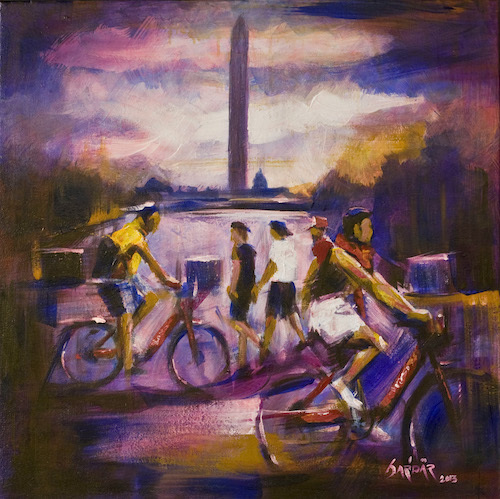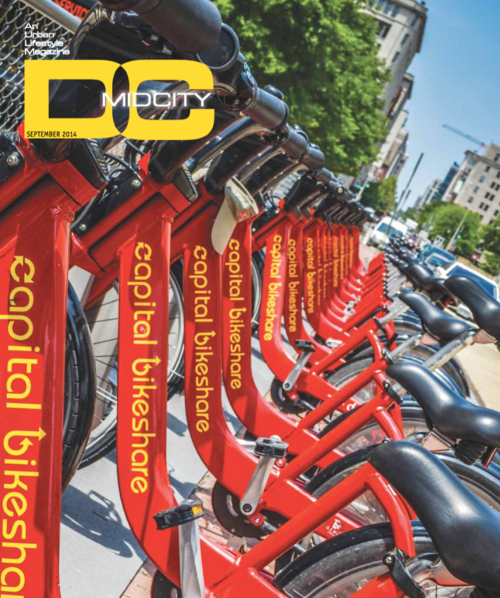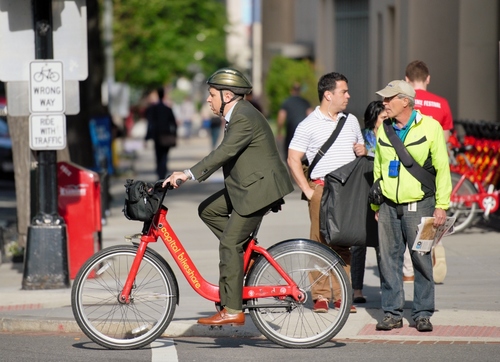Capital Bikeshare, Objet d’art
Capital Bikeshare is celebrating its fifth birthday next week. If the party balloons were thought bubbles, they’d have a lot to say. Wherever you look, it’s plain to see that this two-wheeled public transit mode has permeated Washingtonians’ collective psyche.
In a measure of Capital Bikeshare’s pervasiveness, it’s even depicted in highbrow art. Having transcended the news pages and pop culture, it has captured the imaginations of artists and inspired the creative class to render its interpretations.
The bikes are the focal point of “City Rides” by local impressionist painter Sar’där Aziz.
The system is named in actor Ron Litman’s one-man show, “DC Trash — Recycled,” a native Washingtonian’s culture critique expressed from the cab of a trash truck.
Litman’s provocative social commentary is a broad-brush indictment of wealth, privilege, excess and indifference.
“So you say you wanna live in this town, then lay your money down
And I’ll tell you ‘bout the gold rush — it’s very hush hush
Yeah, there’s gold in them thar hills, and the government gonna pay your bills
So ride bike-share, use your smartfare. Take Uber, Zipcar, just get out there”
CaBi is newsworthy
On the pages of our news, reporters write stories when new CaBi stations are announced. In the features and lifestyle sections, the sturdy red bikes represent symbols of the modern metropolis.
Why, look, there’s a Capital Bikeshare on the cover of Washingtonian’s Best of Washington edition. The July 2015 issue pictures a Washington Nationals mascot on a Capital Bikeshare to illustrate the “150 local faves” inside.
And, look, there’s a photojournalistic statement on the cover of the September 2014 MidCity DC News. No caption needed. The artsy picture by Jazzy Wright speaks for itself.
And there’s Capital Bikeshare in a cheeky game of DC bingo created by Curbed DC. Among the quintessential Washington moments is the one in which you see a “Bikeshare Rider Wearing a Full Suit.” Ryan Lovin photographed one such creature this past Bike to Work Day.

Image from Curbed DC.
CaBi is everywhere
In the shadows of Union Station, a piece of Corner Bakery artwork tells a deeper story than it may seem. The chain restaurant at North Capitol and E Streets NW is filled with framed prints of city life. One stands out for the topical moment it unknowingly captures: the top half of the print shows two young boys eyeing cakes and the bottom half is a Capital Bikeshare station, again speaking for itself without comment.
The juxtaposition alone makes a poignant statement. Just as children are irresistibly drawn to sweets, Washingtonians are attracted to Capital Bikeshare. Today’s youth are tomorrow’s Capital Bikeshare members.
If those two boys were second graders in D.C. Public Schools, they’d be learning to ride bikes at school this year. DCPS has launched a precedent-setting program in which every second grader will be taught to ride a bicycle safely and skillfully. The school district has procured the bikes and developed the lessons, which include a half-day ride in the park for each student.
D.C. is the first U.S. school system to institutionalize comprehensive bicycle education, putting Washington on the leading edge of social change. The most bicycle-friendly European cities have long included bicycle education for schoolchildren. With this game-changing move, D.C. is paving the way for a radical behavior change in the next generation of urban commuters.
Between the children and the artists, a new transportation paradigm is emerging. It doesn’t take a crystal ball to see that the future is now, and it most certainly rides a bike.





